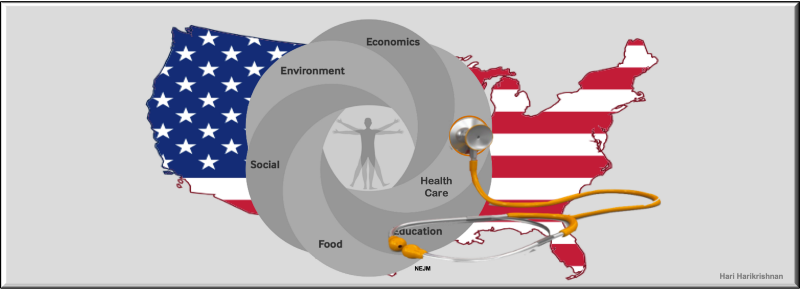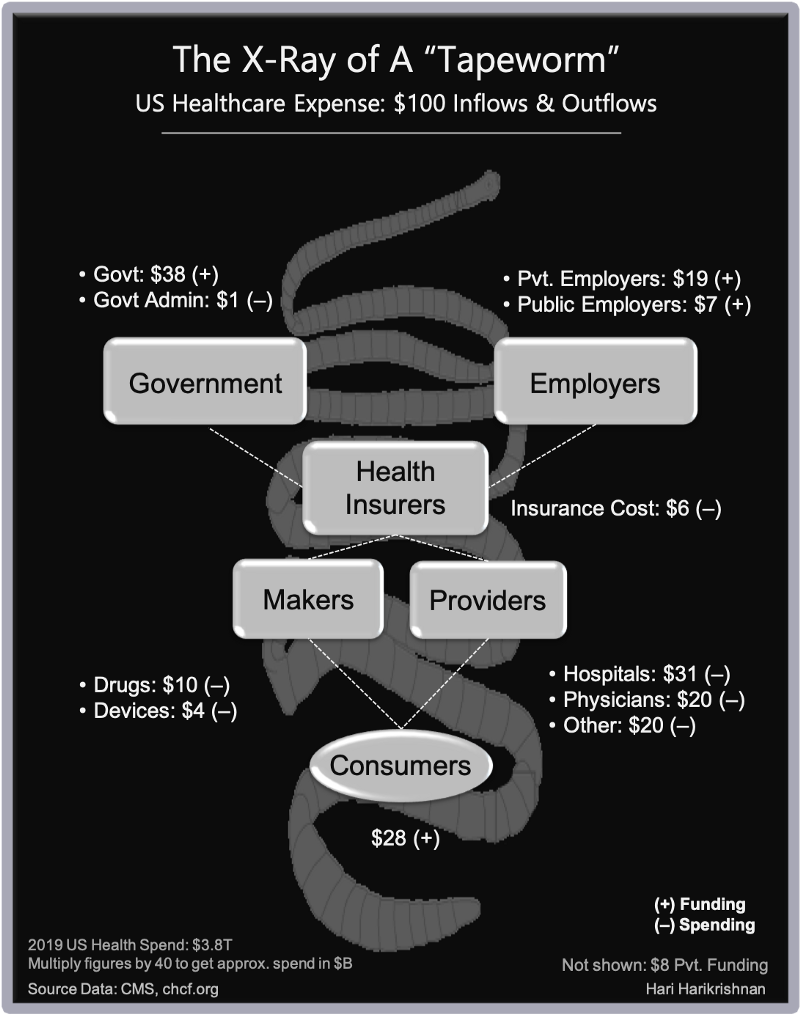How Amazon could redraw the 21st century healthcare landscape — from selling cures to delivering care.

We have heard the rumblings. Amazon is coming!
Not coming to a grocery store near you or to your door with fresh produce, but coming to the healthcare industry. Sightings are reported daily in the form of pharmacy licenses, patent filings, and new venture announcements.
The mere idea that Amazon could enter this sector has sent shockwaves across all players in this industry. Each bracing for the possibility with defensive acquisitions and consolidations.
How can Amazon make inroads into the pharmaceuticals and healthcare industries? How difficult is it compared to its entry to the fresh produce market?
To appreciate what Amazon is stepping into, we need to look at the healthcare system from the pharmaceuticals end (“cure”) to the healthcare delivery end (“care”). We need to consider the key ecosystem players ranging from pharmaceutical makers, distributors, and pharmacies to healthcare providers, insurers, employers, and government.
Let us parse the “what-would-amazon-do?” question in five parts:
- Healthcare supply chain & value chain
- Cure economics
- WWAD: What Would Amazon Do?
- Challenges for Amazon
- Amazon as the 21st century Kaiser Permanente
1. Healthcare Supply Chain & Value Chain
If healthcare were like any other industry, the value chain would look like a typical supply chain that connects consumers to makers of products or providers of services — as shown below.

Physical goods (drugs) flow from makers to the consumer through the distribution channels (red arrow on the left). Care is delivered by providers (blue arrow on the right). [Note: Excludes drugs that are not patient self-administered.]
If only life were that simple!
While products and services flow as shown above, the value chain that enables this flow is more complex. Here lies Amazon’s challenge and opportunity…and our hope for a better healthcare system.
Healthcare Value Chain
Healthcare industry provides the ultimate example that a supply chain does not make a value chain.
The illustration below shows the the cure and care supply chain and the players involved in payment, to complete the value chain of makers, providers, payers, and the intermediaries that facilitate the flow of products and services.
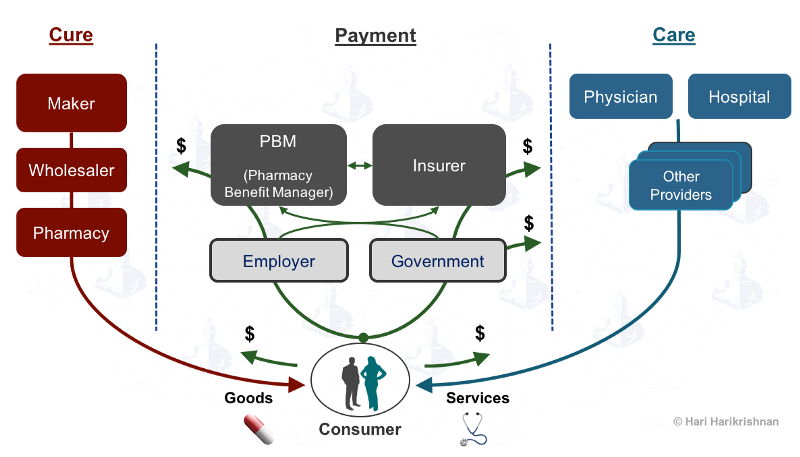
Money flows are shown by the green arrows. It’s a complex web indeed!
Multi-payer systems like in the US makes the payment column complex. Single payer systems like in the UK makes the payment column simpler, consolidating negotiations, administration, and payments, making the government the big intermediary.
This complex web of goods, services, and payment flows is critical to bear in mind when we consider what Amazon could do.
2. Cure Economics
Much talk on Amazon’s entry into healthcare centers around pharmaceuticals distribution and pharmacies — retail and mail-order. Hence, a spotlight on the cure distribution aspect of healthcare will help us understand the potential for disruption in the part of value chain involved in pharmaceutical distribution.
An industry-level analysis by USC Schaeffer Center, breaks down $100 spent on drugs into consumer co-pay and non co-pay, and subsequently attributes it to the players involved in the drug value chain, as shown below.
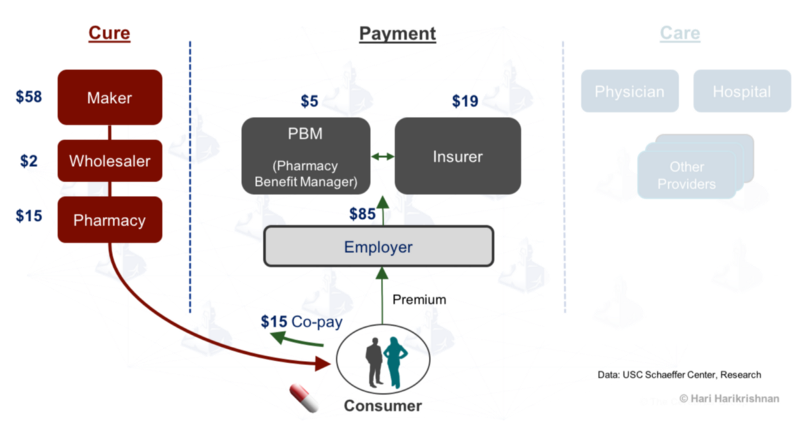
Based on this, about 75% of the spend goes to drug makers and distributors; 25% goes to insurers and pharmacy benefit managers (e.g. Express Scripts, Caremark, Optum)
Here is another look that $100:
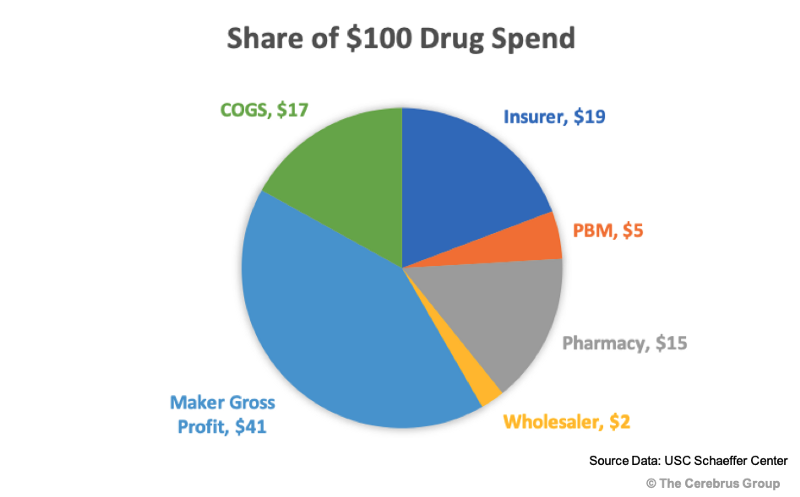
The point of these views is not to debate who deserves to get what in the ecosystem. It is simply to illustrate how this pie could shrink if Amazon entered healthcare and optimized activities in the value-chain, based on their posture and their business goals.
3. WWAD: What Would Amazon Do?
Against this backdrop is the raging discussion on what Amazon would do.
Since we know Amazon is audacious, let’s look at two scenarios for WWAD in terms of two potential Amazon incarnations:
- A) Amazon as Apothecary, disrupting just cure
- B) Amazon as Apothecary and Concierge for Care, disrupting the entire healthcare system.
After all, why stop at just mail order drug delivery or with opening a few retail outlets?
A) Amazon as Apothecary
Amazon disrupting the cure part of the value chain could look like this:
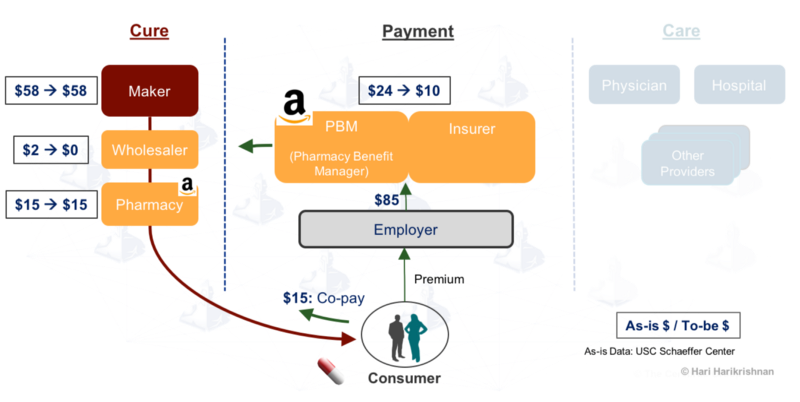
In this incarnation, they paint the town of pharmaceutical distribution orange! They cut out Pharmacy Benefit Managers (PBMs) like Express Scripts and Optum, insurers like United Healthgroup and Aetna, wholesale distributors like McKesson; they open up pharmacies; they ramp up mail order drug delivery…The as-is and to-be dollars show how Amazon could bring about savings.
Amazon can easily shave off 15% off the $100 we pay today, across payment and wholesale arena by consolidating and replacing some middlemen.
That is before even considering account savings in pharmacies or how they can change the relationship with drug makers.
Okay, I said audacious, I didn’t say easy. We’ll do a reality check soon.
B) Amazon as Apothecary and Concierge for Care
Can they go further and disrupt everything? Why not?! They are playing a multi-decade game. They are just two decades old in the world of retail, but look at their impact on retail.
Disrupting everything looks like this:
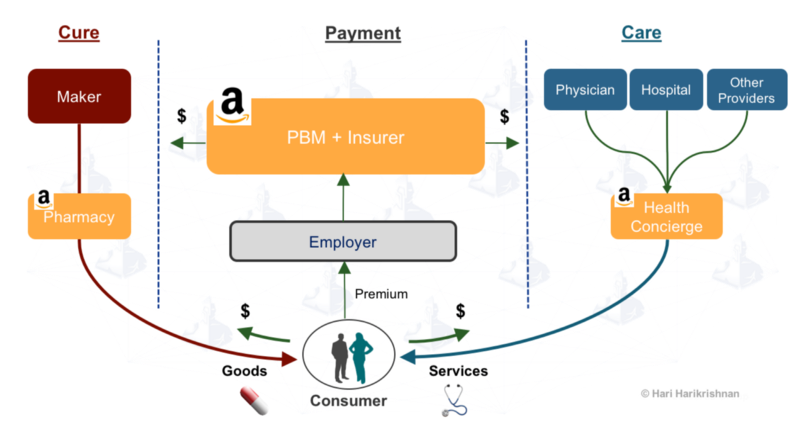
In this incarnation, more parts of the town are painted orange. Amazon becomes a care concierge to coordinate care for us, like the newbie health insurer, Oscar.
Now, time for that reality check.
4. Challenges for Amazon
Playing in healthcare is not like delivering farm-fresh salmon from Whole Foods. But it helps to have that infrastructure in place.
Here is a set of capabilities Amazon will need — developed internally, inorganically acquired, or by orchestrating the ecosystem — to achieve the audacious possibilities above.
Shown below are seven capabilities mapped against each market incumbent type and Amazon.
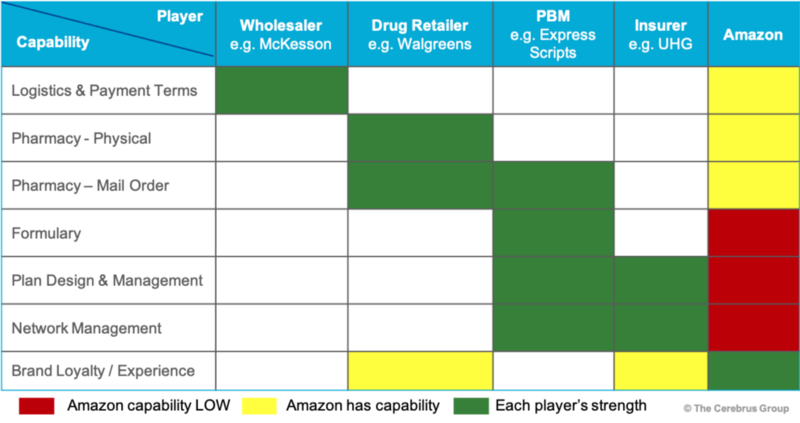
- Green shows each player’s core strength — e.g. a wholesaler like McKesson is strong in logistics and payment terms to others. Amazon’s only green — the most fearsome one for the incumbents — is their reach, their relentless focus on customer experience, and the ensuing brand loyalty.
- Yellow shows where Amazon has capabilities that can be leveraged for drug distribution, but lags behind incumbents significantly. e.g. In the US, Amazon has over 400 possible outlets via Whole Foods. Rite Aid has over 4000. Walgreens and CVS have over 8000. Incumbent’s consumer brand loyalty vs. Amazon is tagged yellow in relation to Amazon’s green. Perhaps I’m being generous here, given insurers’ and existing pharmacies’ NPS (Net promoter Score) vs. Amazon.
- Red indicates minimal or no known capabilities for Amazon today. This is where it needs maximum investments, organic or inorganic. It needs drug formularies and associated programs to keep costs down. It needs capabilities for health and drug plan design and management and sell it to employers (B2B sales, not B2C). It needs to manage a network of providers and pharmacies.
Farm-fresh salmon at your door step via PrimeNow seems like a cakewalk compared to this!
5. The Ultimate Cure for Healthcare?
What if they did all that? What if they became the apothecary and the concierge?
The would look like this. Amazon as an orchestrator of healthcare, just as they have proven themselves to be in retail.
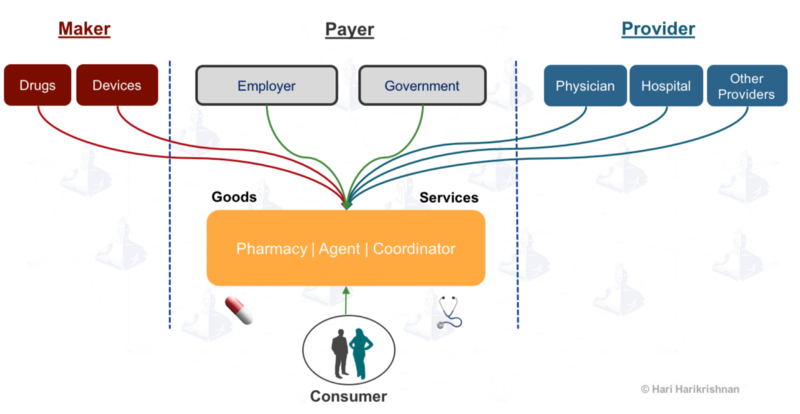
Integrated healthcare delivery systems like Kaiser Permanente act as one-stop-shop for consumers. While the above picture looks similar to an integrated delivery system, an integrated Amazon model could be dramatically different – one that achieves one-stop-shopping via virtual integration of providers (not building hospitals and employing physicians, but using them for services) and consolidation of middlemen in payment and drug distribution.
Is a virtually integrated combination of apothecary and concierge possible?
The recently announced joint venture between Amazon, Berkshire Hathaway, and JPMorgan is confirmation that Amazon is headed there. It gives them a captive customer base of over a million employees to experiment with playing Apothecary and Concierge with a clean sheet of paper.
This is the start of another “Fullfilled by Amazon” (FBA). Except that in this case, it is not our appetite that is being fulfilled, but our health needs.
5. Is Amazon the 21st century Kaiser Permanente?
There are many similarities between Amazon and Kaiser Permanente, the largest Health Maintenance Organization (HMO) in the US.
A brief comparison of the two:
- Employees First: Kaiser pioneered health insurance in the mid 20th century and started providing care and insurance to workers first. Amazon’s captive customer base is also employees, to start with.
- Not-for-profit Care: Kaiser and Amazon joint venture are non-profit. [Amazon itself is arguably non-profit. Read Will Benevolent Bezos Replace Government? to see how]
- Integrated Healthcare: Kaiser is vertically integrated to deliver healthcare. Amazon’s venture likely will be virtually integrated for care delivery. It is a build-vs-buy distinction.
- Scale: Kaiser covers 9 million people. Amazon joint venture will kick-off with 1 million people, when available.
“Medical costs are the tapeworm of American economic competitiveness”, Warren Buffett
Amazon may be just the cure the doctor ordered for the tapeworm — against that bleak backdrop of an industry struggling to balance costs, access, and quality.
Healthcare fulfilled by Amazon (“H-FBA”) available with Amazon Prime subscription, offered by a not-for-profit virtual blend of apothecary and concierge, looks set to alter the 21st century healthcare landscape – much like how Kaiser Permanente changed US healthcare in the 20th century.


